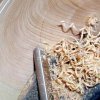Is there an acceptable method to avoid the highs and lows when sanding elm and oak?
-
It's time to cast your vote in the October 2025 Turning Challenge. (click here for details) -
Congratulations to Curt Fuller for "Bell Ornaments" being selected as Turning of the Week for October 27, 2025 (click here for details) -
Welcome new registering member. Your username must be your real First and Last name (for example: John Doe). "Screen names" and "handles" are not allowed and your registration will be deleted if you don't use your real name. Also, do not use all caps nor all lower case.
You are using an out of date browser. It may not display this or other websites correctly.
You should upgrade or use an alternative browser.
You should upgrade or use an alternative browser.
Sanding Advise
- Thread starter cwearing
- Start date
- Joined
- May 16, 2005
- Messages
- 3,540
- Likes
- 22
Rigid or semi-rigid sandpaper backing and don't press.
Best, of course, is to do reasonable gouge work. Both woods you mention don't benefit much by being sanded past (CAMI) 220 with the grain, so it's fairly easy to do a two and out on grits. More grits and more time you spend, worse the problem can get.
Look into these http://www.packardwoodworks.com/Merchant2/merchant.mvc?Screen=CTGY&Category_Code=snding-adiscs-power as a good way to bridge the sander over soft spots. I use 'em, and one step further, because I use the handle of my flex shaft as if it were the shank of a tool. http://s35.photobucket.com/albums/d160/GoodOnesGone/?action=view¤t=150Sand-1.flv
Best, of course, is to do reasonable gouge work. Both woods you mention don't benefit much by being sanded past (CAMI) 220 with the grain, so it's fairly easy to do a two and out on grits. More grits and more time you spend, worse the problem can get.
Look into these http://www.packardwoodworks.com/Merchant2/merchant.mvc?Screen=CTGY&Category_Code=snding-adiscs-power as a good way to bridge the sander over soft spots. I use 'em, and one step further, because I use the handle of my flex shaft as if it were the shank of a tool. http://s35.photobucket.com/albums/d160/GoodOnesGone/?action=view¤t=150Sand-1.flv
- Joined
- Dec 8, 2006
- Messages
- 192
- Likes
- 0
What MM advises. I learned it after I discoverd that while sanding spalted walnut with a soft backing behind my sandpaper I had found a particularly soft spot about the size of a half dollar and had created a depression in an otherwise perfect bowl.
sanding problem
thanks for bringing it up and for the information, i had never really thought about the problem but my highs and lows did seem to get worse the more i sanded oak
if i keep reading this board maybe with osmosis i will learn something
thanks for bringing it up and for the information, i had never really thought about the problem but my highs and lows did seem to get worse the more i sanded oak
if i keep reading this board maybe with osmosis i will learn something
john lucas
AAW Forum Expert
I find the trick is to get a better finish off the tools. Use a freshly sharpened gouge, speed up the lathe and move the tool slower to get a better cut. I'm not using a 40 degree grind on one bowl gouge that I use for finishing cuts or I use a pull cut on a bowl gouge with a long side grind for the outside. Then use a freshly sharpened shear scraper. If this is done properly you can start sanding with light pressure at 180 or 220 and you don't get lumps.
- Joined
- May 16, 2005
- Messages
- 3,540
- Likes
- 22
I find the trick is to get a better finish off the tools. Use a freshly sharpened gouge, speed up the lathe and move the tool slower to get a better cut. I'm not using a 40 degree grind on one bowl gouge that I use for finishing cuts or I use a pull cut on a bowl gouge with a long side grind for the outside. Then use a freshly sharpened shear scraper. If this is done properly you can start sanding with light pressure at 180 or 220 and you don't get lumps.
I think the entire answer is in the shear. It bridges the early/latewood just as the rigid sandpaper backing does, making a fair surface which can be extended into a fair curve. Since I use my shear with benefit of bevel, and push rather than pull so I can stay out of the way of a mishap while getting good visual as well as tactile feedback to start the cut, I cut out a step.
I vary the feed rate rather than speed the lathe. That way I don't get into a high-energy catch situation near the periphery. Square of the velocity, as you recall.
The shaving is wide, which indicates quite a shear, but the cut surface benefits. The shavings will get more narrow and tightly twisted toward the bottom where the curvature is changing rapidly.


